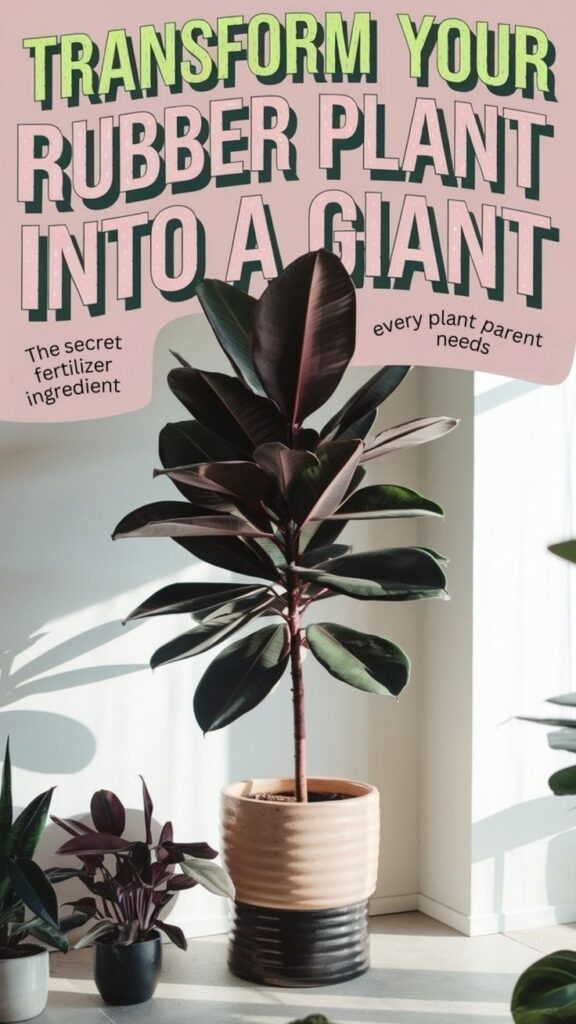If you’re looking to transform your rubber plant from lackluster to lush, you’ll need to master the art of fertilization. While these resilient houseplants can survive on minimal care, they’ll truly thrive when you provide the right nutrients at the right time. The difference between a struggling rubber plant and one that’s bursting with glossy leaves often comes down to your fertilizing strategy—and there’s more to it than simply following the instructions on the package.

Contents
Understanding Rubber Plant Nutrient Requirements
Rubber plants (Ficus elastica) require a balanced mix of vital nutrients to thrive and maintain healthy growth. The primary nutrients needed are nitrogen (N) for leaf development and overall growth, phosphorus (P) for root development and energy transfer, and potassium (K) for overall plant health and disease resistance. Secondary nutrients like calcium, magnesium, and sulfur are also essential for proper plant development.
During the growing season (spring and summer), rubber plants benefit from regular fertilization with a balanced, water-soluble fertilizer with an NPK ratio of 10-10-10 or similar. The fertilizer should be applied monthly when the plant is actively growing, but reduced or stopped completely during winter months when growth naturally slows. Over-fertilization can lead to leaf burn and root damage, so it’s important to follow recommended dosage instructions and monitor the plant’s response.
Best Fertilizer Types for Rubber Plants
Rubber plants thrive best with a balanced, water-soluble fertilizer that contains equal parts nitrogen, phosphorus, and potassium (NPK ratio of 10-10-10 or similar). During the growing season (spring and summer), these plants benefit from monthly applications of such fertilizer, which promotes healthy leaf growth, strong root development, and overall plant vigor.
Organic alternatives like fish emulsion, seaweed extract, or well-rotted compost can also provide excellent nutrition for rubber plants. These natural options release nutrients slowly and help improve soil structure while reducing the risk of fertilizer burn. Additionally, supplementing with magnesium through Epsom salt solutions can enhance chlorophyll production and promote deeper green foliage, though this should be done sparingly, typically every few months during the growing season.
When and How Often to Feed Your Rubber Plant
Rubber plants require regular fertilization during their active growing season, which typically runs from spring through early fall (March to September). During this period, feed your rubber plant every 2-4 weeks with a balanced, water-soluble fertilizer diluted to half strength. In winter months, reduce fertilizing to once every 6-8 weeks or stop completely, as the plant’s growth naturally slows down.
The type of fertilizer matters greatly for rubber plants. Use a balanced NPK fertilizer with a ratio of 10-10-10 or similar, which provides the necessary nitrogen for leaf growth, phosphorus for root development, and potassium for overall plant health. Always apply fertilizer to moist soil to prevent root burn, and guarantee proper drainage to avoid nutrient buildup that can damage the plant’s root system.
Signs of Nutrient Deficiency and Overfertilization
Signs of nutrient deficiency in rubber plants typically manifest through leaf discoloration and growth issues. Yellow leaves often indicate nitrogen deficiency, while purple-tinted leaves suggest phosphorus deficiency. Pale leaves with green veins point to iron deficiency, and brown leaf edges commonly signal potassium deficiency. Stunted growth and smaller-than-normal leaves can also indicate various nutrient shortages.
Overfertilization presents differently, with symptoms including leaf burn, brown spots, wilting, and salt buildup on the soil surface. The plant may show rapid but weak growth, and leaf edges might become crispy and brown. In severe cases, overfertilization can lead to root damage, causing the plant to drop leaves and potentially die if the issue isn’t addressed promptly. Excess fertilizer salts can also prevent proper water absorption, leading to dehydration despite moist soil.
Seasonal Fertilizing Tips for Optimal Growth
Seasonal fertilizing for rubber plants requires adjusting nutrient delivery based on their growth cycles throughout the year. During the active growing season (spring and summer), rubber plants benefit from monthly applications of balanced, water-soluble fertilizer with an NPK ratio of 10-10-10 or similar. The fertilizer should be diluted to half-strength to prevent root burn while providing essential nutrients for leaf development and overall growth.
In fall and winter, fertilizing should be reduced considerably or stopped altogether as the plant enters a period of slower growth or dormancy. This reduction prevents excess nutrients from accumulating in the soil and potentially damaging the root system. Resume regular fertilizing in early spring when new growth begins to appear, gradually increasing the frequency as daylight hours lengthen and temperatures warm up.
Creating a Year-Round Fertilization Schedule
During the growing season (spring and summer), rubber plants require monthly fertilization with a balanced, water-soluble fertilizer (such as 10-10-10 or 20-20-20). Apply the fertilizer at half-strength to prevent root burn, and make sure the soil is moist before application. For best results, fertilize every 3-4 weeks from March through September.
In fall and winter, reduce fertilization considerably as the plant enters its dormant phase. Feed the plant every 6-8 weeks with a diluted fertilizer solution, or stop fertilizing altogether if growth has slowed markedly. Resume regular fertilization in early spring when new growth begins to appear. Always monitor the plant’s response to fertilization and adjust the schedule if leaves show signs of burning or yellowing.
